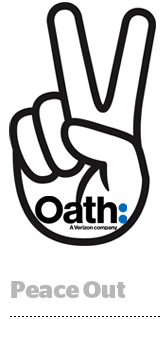
Here’s today’s AdExchanger.com news round-up… Want it by email? Sign up here.
Oath Ad Server, Peace Out
Verizon Media will shutter the Oath ad server in 2020, Adweek reports. The Oath DSP and SSP products aren’t affected, and Verizon will be shifting investments to higher-growth revenue streams, such as connected TV, streaming audio and adoption of its mobile app SDK. Many ad tech owners have been tempted to cut ad server offerings, since the business comes with high infrastructure costs and headcount. There also isn’t much growth because Google dominates the market and there’s a large field of alternatives in the mix. The looming question is whether Verizon Media remains as committed to its plan to build a data-driven ad platform to rival other internet giants. “There was much promise for the combined AOL-Yahoo-Oath ad stack, and as Verizon has made 5G its core effort, the company appears to have decided that ad tech is not the bet they want to make.” More.
CPG Vs. DTC: Round 2
Legacy product brands are reasserting their strength with US consumers and retailers after years of market share losses to direct-to-consumer startups. The retail conference Shoptalk in Las Vegas this week is a microcosm of that trend. There are fewer independent DTC brands leading the show, with mainstays like Bonobos, Dollar Shave Club and Trunk Club acquired by incumbents (Walmart, Unilever and Nordstrom, respectively), reports 2PM, a commerce news company. And DTC startups that have grown into meaningful businesses mostly embrace TV and brick-and-mortar retail. After weathering a tough few years, large brands can strike back. P&G accounts for 18% of Walmart’s in-store sales, up from 15% in 2016. That’s a lot of leverage to potentially box DTC rivals out of the largest US grocery chain. If established CPGs can contain DTC growth to ecommerce and Facebookagram performance marketing, they can wait out the VC money while developing their own consumer-direct product lines. More.
A Tangled Web We’ve Woven
Procter & Gamble is testing the bounds of cross-agency relationships with its creative and media-buying accounts that span WPP and Publicis agencies. “I can see how, when you’re not involved, it can seem pretty foreign. People are curious about it from a business and creative standpoint,” says Joe Mongognia, executive director for WPP’s Grey and one of three executive creative directors for Woven, P&G’s boutique agency collab. (The other two executive creative directors are from Publicis shops). Other blue-chip brands are using multiple agencies, in part because bulk ad buys don’t return the same benefits in data-driven advertising as they do with old-school TV and radio. Expertise and exclusive data or media is therefore more important. But don’t discount trust, or the lack thereof, as another motivator here. Some brands have lost faith in their agencies and maintain overlapping agency relationships to try and keep everyone in line. More in Ad Age.
But Wait, There’s More!
You’re Hired!
This post was syndicated from Ad Exchanger.


More Stories
Daily Wire Welcomes Perplexity to Advertise on The Ben Shapiro Show
Here’s the Roundup for the Week Ending March 7
Aflac’s Dan Amos Reveals How He’s Successfully Held Onto the CEO’s Job for 35 Years